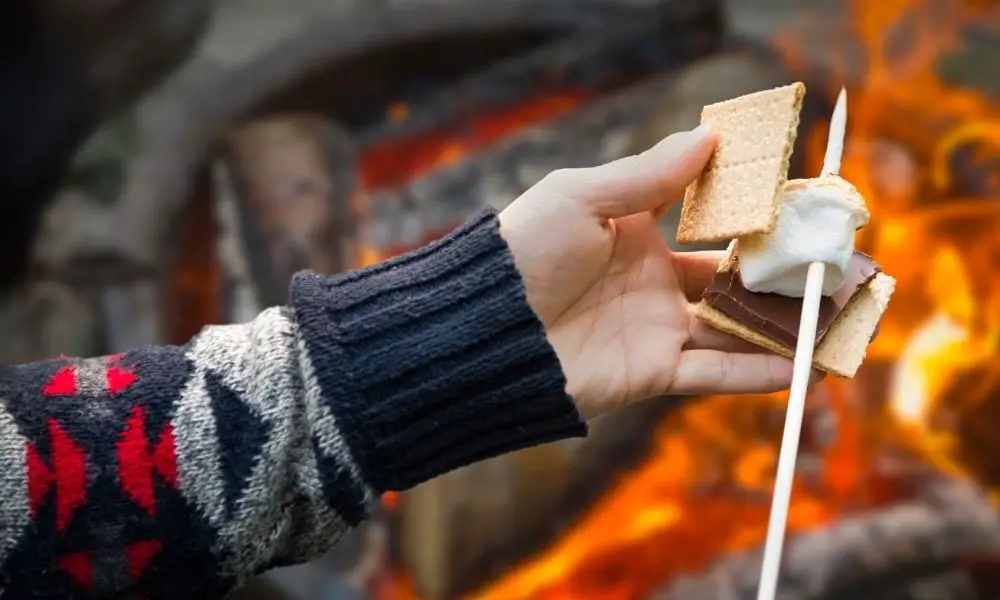

Humanity has been cooking and heating up food with fire for millions of years. Using fire as a means to cook is no novel idea, but it takes a bit of background knowledge to understand what’s going on inside all the flames. Above the fire is a rising heat called convective flow, and these hot gases can easily ignite certain food items, including the precious marshmallows humans love to roast over a fire to make s’mores.
Scientifically speaking, these marshmallows appear as instant fuel sources because of their sugary composition that consists of oxygen, hydrogen, and carbon. It takes a little skill, technique, and insight to brown one to perfection. Let’s take a closer look at the science behind toasting the perfect marshmallow so you can impress others with your knowledge next time.
Generally, the basis of a marshmallow is only a few components. You need to know exactly what ingredients are present in order to understand why they toast the way they do. Sugar makes up the basic structure, while egg whites traditionally create the foamy texture. Gelatin is a staple for marshmallow stability, while water is the very thing that helps hold it all together. These four ingredients will react precisely to the fire and brown the marshmallow through the science of chemistry.
In every fire, there are several processes of heat transfers that occur: conduction, convection, and radiation. Conduction isn’t relevant to browning marshmallows, but convection and radiation are. As mentioned above, convective flow is the gases that rise off the visible flames. Due to their speed and movement, these are not ideal to brown a marshmallow. Instead, toasters should stay to the side of the flames and hover over the glowing coals to best caramelize the marshmallow. Patience is always the key to achieving a perfectly roasted (and not burnt) marshmallow.
Whether you make a campfire on a beach in the summer or install an outdoor fireplace or fire pit to enjoy throughout the changing seasons, anyone can enjoy a perfectly toasted marshmallow at any time. The science behind toasting the perfect marshmallow is easier than you think. It just takes the right strategy. When you patiently hover over the burning wood or coals, radiant energy provides a consistent heat source to roast the marshmallow.
With precise rotation, the marshmallow puffs up from the internally expanding air pockets, and all the sides turn into that wonderful deep brown color. This is because of a natural chemical change that occurs called the Maillard reaction. The sugar molecules in the marshmallow react with proteins, melt the water component, and turn into complex, tasty, and gooey compounds. You can visibly see the transformation the marshmallows endures from beginning to end. Pretty neat, right? All you need now is some chocolate and graham crackers to seal the deal for a perfect sumptuous treat.
FAQ
In every fire, there are several processes of heat transfers that occur: conduction, convection, and radiation. Conduction isn’t relevant to browning marshmallows, but convection and radiation are. As mentioned above, convective flow is the gases that rise off the visible flames. Due to their speed and movement, these are not ideal to brown a marshmallow. Instead, toasters should stay to the side of the flames and hover over the glowing coals to best caramelize the marshmallow. Patience is always the key to achieving a perfectly roasted (and not burnt) marshmallow.
Additional Resources:
Peanut Butter
Protein
Clif Bars
RxBar
CBD Gummies
Learn essential first-time landlord tips for success, from tenant screening to property maintenance. These strategies…
Every business will produce some form of waste. The real task isn’t preventing waste entirely—it’s…
Custom tailors can create unique garments that complement every inch of your body, and it’s…
Faulty wiring can ruin a perfect restoration. See how original-style harnesses preserve WWII Jeep reliability,…
Make reading more accessible for kids with dyslexia using these nine tools designed to build…
Optimize your food processing facility by better understanding the critical ways gases can impact electrical…